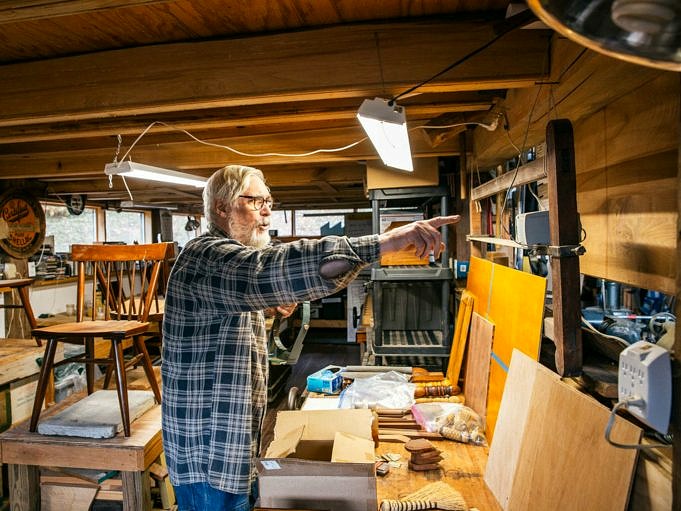Last week, I had the inestimable pleasure of spending a few hours with Don Williams, senior furniture conservator for the Smithsonian Institutions Museum Conservation Institute (MCI) at the Museum Support Center in Suitland, Md. I got to see only a small part of the compound that in addition to many offices, microscopy, X-ray and other labs (when did scanning electron microscopes get so tiny? The library, which also serves as a work space for many types of projects, including painting restoration and textile repair, is home to five pods that are football-field in size. There are large storage rooms with artifacts and specimens stacked up to the ceilings at 71 cm. The MSC has 435,000 square feet of storage space for collections. I got to stick my head into Pod 4, part of which is dedicated to oversized artifacts, which are each stored on a stainless steel (I think it was stainless steel) crate/pallet with custom modifications for each to properly support the item inside. The entire area is controlled in temperature and humidity. Although you cant see whats behind the shrouds, the sheer number of the stacked crates is awe inspiring.
Move out of the pod, and the experience becomes humbling. The people I met are among a rarified few in the entire world who can do what they do and theyre the experts entrusted variously with identifying, arresting and at times repairing damage (among other things) to priceless and irreplaceable artifacts those owned by the Smithsonian as well as other museums and collections that sometimes call on the expertise of the MCI conservators. I was afraid to touch any object (we couldn’t even enter the textile studio as I was wearing a wool sweater. I was told that wool can carry too many things with it that could cause contamination of the space and items within.
I felt a little less like a rube in Dons studio because much of the stuff in it is recognizable theres a wood rack in one corner, two workbenches with planes, clamps and saws atop them, a row of cabriole legs, a sharpening station, what appear to be half-finished projects, and large flat storage drawers with carefully sorted screws and other supplies (OK that last ones not familiar but I wish it were).
Half-finished projects are not only useful tools, but also examples of Don’s creativity. In the picture at right, for instance, Don is inserting into a visitor chair from the House chamber a plywood and polymer seat onto which material can be upholstered, thereby relieving the need to tack upholstery directly to the chairs rails time and again over the years (which would be the typical procedure for attaching new fabric). A polymer chair back that attaches to the chair frame with cabinet roller clips was also created by Don. This eliminates the need for upholstery to be attached directly to the frame. Im a seat-of-pants engineer, he says. In a small coffee shop, I do structural engineering.
Don’s unique swiveling tool for small parts of material is another example of his cleverness. It’s made from a pink duckpin bowlingball, some plywood, and a few toilet flanges.
Don’s studio is very clean, as he works on one project at a given time. Hes recently finished restoring an ornate picture frame, molding pieces from plaster and hot glue to replace broken areas, then re-gilting it. Jia-sun Tsang is currently restoring the painting inside. Those in different specialties often work together on projects. If someone has a really intriguing problem, says Don, Ill figure out a way to become a part of it.
Right now, Don is working on what he calls a 17th/18th/19th/20th century Italian/German/Spanish/English ivory marquetry cabinet on which some of the thick ivory inlay pieces are lifting. It’s part of the Cooper-Hewitt National Design Museum, New York. Because it is a design museum the piece must look good and not be damaged. So, Don is working on a way to bend the ivory back in place. Hes experimenting with gun stock methods of scoring diamond hatches on the back of some sample ivory, in order to be able to bend it. Once he has the method perfected, hell remove each piece thats lifting from the cabinet, score the back then glue it back in its original orientation. Hell add new material where pieces are missing, and ink in the etched design to match, adding a metal to the inking material so that it shows up clearly under X-ray. He expects to be working on it for at least the whole of 2011, and likely longer.
Don’s favorite project has been the restoration of a silverstick. Hes talking about the Mace of the United States House of Representatives, the ceremonial symbol of the sergeant at arms. The current one has been in use since 1842, when it replaced the original one (from 1789) that was destroyed when the Capitol Building burned during the War of 1812 (there was a wooden mace in the interim). Don says that this lab unit has taken care of the Mace for 50 years. It is truly one of the greatest artifacts in the Republic.
Don’s office is filled to the girders of books. While many are woodworking and furniture history books, Dons book collection focuses primarily on chemistry as his primary expertise is in furniture colors and finishes. Theres also an overstuffed easy chair that had to be cleaned off before I was invited to sit down, Dons desk (also covered with books) and his chair. Rest of the furniture is made up of books as he spends a lot of his time researching and writing. I spend as much time putting together preservation strategies as restoring, he says. It is literally a job that I get paid to read old manuals. I wont deny, its a pretty good job.
To see all the images at full size with descriptions click here
ShopWoodworking.com offers Glen’s 18th-century American Furniture. D. Huey.



